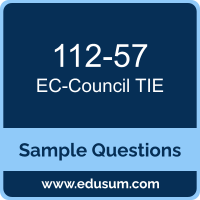01. What is the role of the MITRE ATT&CK framework in understanding the cyber threat landscape?
a) It provides a comprehensive matrix of tactics and techniques used by threat actors
b) It is used to train new employees about general IT skills
c) It simplifies legal compliance unrelated to cybersecurity
d) It is unrelated to cybersecurity and focuses on physical security
02. In what way do TIPs facilitate better information sharing within and between organizations?
a) By limiting access to information
b) Through collaboration features that allow secure sharing of intelligence
c) By only allowing top management to access intelligence
d) They do not support information sharing
03. How do threat actors, attack vectors, and vulnerabilities collectively shape the cyber threat landscape?
a) They have no significant interaction
b) They are independent factors that do not influence each other
c) They collectively define the nature and potential impact of threats in the landscape
d) They decrease the need for cybersecurity
04. What is the significance of the geopolitical and economic context in analyzing the cyber threat landscape?
a) It is only relevant for multinational corporations
b) It has no real impact on cyber security
c) It is primarily important for historical research
d) It provides key insights that influence cyber threats and their impacts on global security
05. Describe the importance of identifying Indicators of Compromise (IoCs) in the cyber threat landscape.
a) IoCs are only useful for post-incident reporting
b) They help in identifying signs of potential or actual security breaches
c) They are primarily used for financial audits
d) They decrease the operational efficiency of security teams
06. Why is hands-on experience with threat intelligence platforms essential for cybersecurity professionals?
a) It is not essential but provides a minor benefit
b) Hands-on experience is only necessary for senior management
c) It helps them practically apply theoretical knowledge and improve their ability to use threat intelligence effectively
d) It is only needed for compliance purposes
07. Why is it important for cybersecurity professionals to understand threat intelligence lifecycles and maturity models?
a) To manage payroll systems more effectively
b) To increase social media engagement
c) To improve sales strategies
d) To develop and enhance threat intelligence programs systematically
08. What is a key benefit of visualizing intelligence findings?
a) It makes reports less detailed
b) It uses more resources without providing additional insights
c) It helps stakeholders quickly understand complex data and trends
d) It is only for aesthetic purposes
09. How does establishing a defensive cybersecurity lab environment benefit students in threat intelligence?
a) It provides a controlled setting for practical application and experimentation with threat intelligence tools and techniques
b) It reduces the cost of cybersecurity education
c) It eliminates the need for real-world experience
d) It focuses on theoretical knowledge only
10. Why is it crucial to integrate threat intelligence with risk management?
a) To increase the financial risks to the organization
b) To focus risk management on external business investments
c) To reduce the importance of risk management
d) To ensure that threat intelligence efforts are aligned with the organization's risk appetite and management strategies
 The purpose of this Sample Question Set is to provide you with information about the EC-Council Threat Intelligence Essentials exam. These sample questions will make you very familiar with both the type and the difficulty level of the questions on the 112-57 certification test. To get familiar with real exam environment, we suggest you try our Sample EC-Council TIE Certification Practice Exam. This sample practice exam gives you the feeling of reality and is a clue to the questions asked in the actual EC-Council Threat Intelligence Essentials (TIE) certification exam.
The purpose of this Sample Question Set is to provide you with information about the EC-Council Threat Intelligence Essentials exam. These sample questions will make you very familiar with both the type and the difficulty level of the questions on the 112-57 certification test. To get familiar with real exam environment, we suggest you try our Sample EC-Council TIE Certification Practice Exam. This sample practice exam gives you the feeling of reality and is a clue to the questions asked in the actual EC-Council Threat Intelligence Essentials (TIE) certification exam.